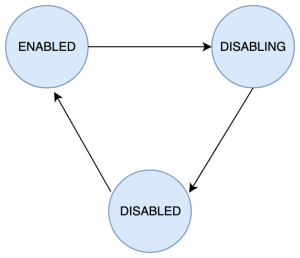This page is meant as a template for writing a KIP. To create a KIP choose Tools->Copy on this page and modify with your content and replace the heading with the next KIP number and a description of your issue. Replace anything in italics with your own description.
Authors: Mehari Beyene, Divij Vaidya
Collaborators: Karthik Rajagopalan, Nagarjuna Koduru
Status
Current state:"Draft"
Discussion thread: here [Change the link from the KIP proposal email archive to your own email thread]
JIRA: KAFKA-7739
Please keep the discussion on the mailing list rather than commenting on the wiki (wiki discussions get unwieldy fast).
Motivation
This proposal aims to address a gap in the existing functionality introduced by KIP 405, which enabled customers to enable Tiered Storage but did not provide the capability to disable it. To enhance the flexibility and control of data storage in Kafka clusters, we propose the introduction of a Tiered Storage disablement feature. This feature will allow customers to selectively disable Tiered Storage on a per-topic basis. There are several reasons why customers would be interested in this feature:
- Flexibility: Currently, customers can enable Tiered Storage but lack the ability to disable it, creating a one-way decision that may discourage them from fully exploring the feature. By introducing the Tiered Storage disablement feature, we offer customers the flexibility to enable or disable the feature as needed, empowering them to make informed choices that align with their specific requirements.
- Cost Optimization: When data is duplicated in both local and tiered storage, it incurs costs for both tiers. However, not all customers require long-term tiered storage for their data. By providing the option to disable the feature, customers can save costs when Tiered Storage is not necessary, allowing them to optimize their expenses without compromising data retention needs.
- Temporary or Experimental Setups: The Tiered Storage disablement feature grants customers the ability to conduct temporary experiments and evaluate the benefits of tiered storage without committing to a permanent architectural change in their data pipelines. By enabling customers to disable Tiered Storage when not needed, they can easily evaluate the impact and advantages of the feature, fostering a culture of experimentation and informed decision-making.
- Compatibility: Allowing customers to disable the Tiered Storage feature enhances the compatibility of Kafka clusters. It enables seamless migration between different Kafka versions or service providers that may not support Tiered Storage. By offering the option to disable Tiered Storage, customers can smoothly transition their Kafka deployments, ensuring compatibility and reducing potential operational challenges.
Goals/Requirements
- Disable Tiering on a Topic: Customers should have the ability to disable tiering on a topic that has Tiered Storage enabled.
- Retention of Tiered Data: When disabling tiered storage on a topic, customers should have the option to retain the tiered data according to the configured retention policy prior to disabling tiering.
- Deletion of Tiered Data: When disabling tiered storage on a topic, customers should have the option to delete the tiered data in the remote storage associated with that topic.
- Fetching Previously Tiered Data: Customers should have the option to continue fetching data that was previously tiered before the tiered storage disablement. This allows them to access and consume the tiered data even after the tiering feature has been disabled.
- Re-enabling Tiering on a Previously Disabled Topic: Customers should be able to re-enable tiering on a topic that was previously disabled, allowing them to resume tiered storage for that specific topic.
- Support for Both Kraft and ZooKeeper-Based Clusters: The tiered storage disablement feature should be designed and implemented to support both Kraft and ZooKeeper-based Kafka clusters, ensuring compatibility across different cluster configurations.
Non-Goals
The following aspects are considered as non-goals for the tiered storage disablement feature:
- System-Wide Disablement: The tiered storage disablement feature does not aim to support the system-wide disablement of tiered storage on a cluster level, as this is controlled by the cluster-level configuration
remote.log.storage.system.enable. - Support for Compacted Topics: Tiered Storage is not supported for compacted topics, and this behavior will remain unchanged. During re-enablement, the feature will not support tiered storage for compacted topics. When initially enabling tiered storage for a topic, we check that the topic does not have compaction enabled, however, if the topic has historically used a compaction policy, we do not perform deep check to restrict tiered storage enablement. This behavior will remain consistent during re-enablement as well.
Proposed Changes
Concepts
Remote Log Disablement Policy
When disabling tiered storage on a topic, users will have the option of retaining or deleting the remote log at the time of disablement. This is represented by a remote log disablement policy. It will be an optional policy that users can specify. By default, we will retain the remote log.
- remote.log.disable.policy=retain: Logs that are archived in the remote storage will be part of the contiguous "active" log. Clients can fetch the archived log, but no new data will be archived to the remote storage.
- remote.log.disable.policy=delete: Logs that are archived in the remote storage will not be part of the contiguous "active" log and will be deleted asynchronously as part of the disablement process.
Tiered Epoch
The tiered epoch signifies the version of a tiered storage topic. This epoch establishes a boundary for the transition from the enabling to disabling state, preventing concurrent and out-of-order modifications. Its aim is to guarantee that all activities within the disablement process are fully completed before permitting the re-enablement of tiering.
State Transitions
When users disable tiered storage on a topic, the tiered storage state on a topic transitions through the following stages: ENABLED → DISABLING → DISABLED.
